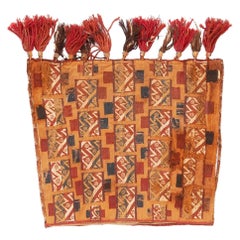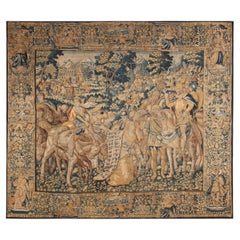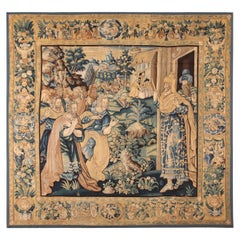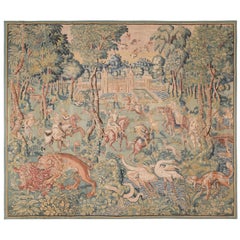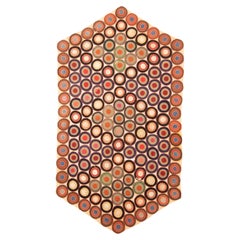Nazmiyal Furniture
6
to
6
6
6
6
37
193
823
663
320
172
42
5
10
2
5
2
3
1
6
6
3
4
4
1
1
1
Period: 16th Century
Amazing Early 16th Century Peruvian Textile 1'2" x 1'4"
Located in New York, NY
Amazing Early 16th Century Peruvian Textile, Circa date: Late 16th Century
Category
Antique 16th Century Peruvian Other Quilts and Blankets
Materials
Wool
16th Century Antique Flemish Tapestry. 11 ft 4 inx12 ft 10in
Located in New York, NY
16th Century Antique Flemish King Solomon Tapestry, Country Of Origin: Belgium, Circa Date: 16th Century. Size: 11 ft 4 in x 12 ft 10 in (3.45 m x 3.91 m)
Category
Antique 16th Century Belgian Renaissance Tapestries
Materials
Wool, Silk
16th Century Antique Flemish Tapestry. 10 ft 8 inx 11 ft 3in
Located in New York, NY
16th Century Antique Flemish Silk And Wool Biblical Scene Tapestry, Country Of Origin: Belgium, Circa Date: 16th Century. Size: 10 ft 8 in x 11 ft 3 in (3.25 m x 3.43 m)
Category
Antique 16th Century Belgian Renaissance Tapestries
Materials
Wool, Silk
16th Century Antique Flemish Tapestry. 10 ft 2 in x10 ft 9in
Located in New York, NY
16th Century Antique Flemish Silk And Wool Tapestry, Country Of Origin: Belgium, Circa Date: 16th Century. Size: 10 ft 2 in x 10 ft 9 in (3.1 m x 3.28 m)
Category
Antique 16th Century Belgian Renaissance Tapestries
Materials
Wool, Silk
Antique Belgian Tapestry. Size: 8 ft x 9 ft 6 in
Located in New York, NY
Marvelous Antique Belgian Tapestry, Country of Origin / Rug Type: Belgium, Circa date: 16th century. Size: 8 ft x 9 ft 6 in (2.44 m ...
Category
Antique 16th Century Belgian Renaissance Western European Rugs
Materials
Wool
16th Century Ming Dynasty Dragon Chinese Carpet Fragment. 3 ft x 3 ft
Located in New York, NY
Breathtaking and Highly Collectible Antique 16th Century Ming Dynasty Dragon Chinese Fragment, Country of Origin: China, Circa Date: 16th Century. Si...
Category
Antique 16th Century Chinese Other Chinese and East Asian Rugs
Materials
Wool
Related Items
American Wool Applique Penny Rug, Late 19th / Early 20th C
Located in Istanbul, TR
These were used as cover rather than rugs. Lots of wool pieces have been used to make this appliqué cover.
Category
Early 20th Century American American Craftsman North and South American ...
Materials
Wool
New Modern Design Handwoven Flat Rug Kilim size 6ft 6in x 9ft 10in
Located in Saint Ouen, FR
Beautiful new Kilim with geometrical modern design and light colors, entirely handwoven with wool on cotton foundation.
Category
2010s Indian Modern Western European Rugs
Materials
Wool
Antique 17th Century Flemish Tapestry 7'11" X 5'9"
Located in Los Angeles, US
A wall hanging tapestry, simply put, is a textile specifically designed and woven to portray an artistic scene with the intent of hanging it on a wall. Antique tapestries, those that...
Category
Antique 17th Century Unknown Other Tapestries
Materials
Wool, Cotton
Antique Chinese Art Deco Rug with Ming Dynasty Style
Located in Dallas, TX
77449, antique Chinese Art Deco rug with Ming Dynasty style. This hand knotted wool antique Chinese Art Deco rug features a color-blocked field and border scheme festooned with asymm...
Category
Early 20th Century Chinese Ming Chinese and East Asian Rugs
Materials
Wool
Kilim Cushion Cover Sky Blue Traditional Wool Scatter Cushion Pillow
Located in Hampshire, GB
This new traditional kilim cushion cover is a handwoven piece constructed in the early 21st century. The design has been delicately woven by hand and features a symmetrical geometric...
Category
Early 2000s Afghan Mid-Century Modern Pillows and Throws
Materials
Wool, Cotton, Natural Fiber, Organic Material
Antique French Aubusson Tapestry
Located in New York, NY
The Aubusson tapestry manufacture of the 17th and 18th centuries managed to compete with the royal manufacture of Gobelins tapestry and the privileged position of Beauvais tapestry. Tapestry manufacture at Aubusson, in the upper valley of the Creuse in central France, may have developed from looms in isolated family workshops established by Flemings that are noted in documents from the 16th century.
Typically, Aubusson tapestries depended on engravings as a design source or the full-scale cartoons from which the low-warp tapestry-weavers worked. As with Flemish and Parisian tapestries...
Category
Antique 19th Century French Aubusson Tapestries
Materials
Wool, Silk
Mid-20th Century Handmade Chinese Art Deco Pictorial Dragon Throw Rug
Located in New York, NY
A vintage Chinese Art Deco throw rug handmade during the mid-20th century with a pictorial design of a dragon in black, blue, red, goldenrod, and light blue-grey over a cream-white borderless field.
Measures: 1' 3" x 1' 6"
The craft of the hand-knotted carpet in China, and the surrounding areas including Mongolia and Tibet, extends into the early centuries of the first millennium, C.E., but we really have a firm grasp only beginning in the later 16th century with large, very coarsely woven carpets, often depicting dragons, created for the Imperial Forbidden City palaces. Chinese carpets have always been commercial and there are no tribal groups responsible for any of the carpet weaving strains.
When the Ming Dynasty fell in 1644, with no Imperial patrons, production moved to the city of Ningxia in north central China where several workshops turned out more finely woven pieces for the Mandarins of the administrative Ch’ing bureaucracy and well-to-do merchants. Ningxia was the major Chinese carpet center up through most of the 19th century, with first allover and then medallion designs on cotton foundations in medium weaves. Palettes were initially limited to yellows, dark blue and cream, but later widened to include reds, browns and even green. These antiques were the first Chinese carpets to be exported to the West and they fitted in well with the craze for Chinese blue-and-white porcelain in the second half of the 19th century. Ningxia also wove shaped and rectangular small rugs for saddle underlays, chair (“throne”) seats and shaped backs, pillar carpets with dragons or monks for Buddhist monasteries, and long divided runners for monastery meditation halls. These small rugs are among the most collectible of all Chinese weavings.
Weavers from Ningxia set up workshops in the capital Peking (Beijing) in the 1860’s and began weaving Western room sizes for export, primarily to America. In blue – and – white and polychrome palettes, with round wreath medallions, precious objects, seasonal flowers, paeonies, lotuses, fretwork, clouds, butterflies and bats, all relatively spaciously drawn. The round “Shou” (Good Luck) character is also a prominent decorative motif. There are also a few Peking landscape pictorials with pagodas, houses, bridges, waterscapes and boats. Peking carpets were woven right up until WWII and production began again after the Cultural Revolution around 1970. They are moderately well-woven, on cotton foundations, exactingly executed and indisputably Chinese. Many are in the blue-and-white style. Nothing else looks like a Peking carpet and for a Chinese “look” in a room, they are absolutely indispensable. Sizes range from scatters and a few runners, through the popular 9’12’ size, to large carpets over 20’ which must have been special orders. The earliest Peking Revival carpets are pliable and fairly thin, but they became heavier and more compact in the 20th century, in competition with Art Deco carpets from Tientsin. The modern, post- 1970, pieces are in the traditional Peking style, but are a little too regular and neat. Exactitude has been favored over character, as hard to explain that as it is.
There are a number of all-silk and silk-and –metal thread pieces, many with inscriptions purporting to link them with rooms in the Imperial palaces, bringing very substantial auction prices, but none are really antique. The genre emerged after WWI and the present demand comes from mainland Chinese. The silk piles often stand in pattern relief against flat woven gold metal thread grounds. The inscriptions are apocryphal, the rugs are flashily opulent, perfect for nouveaux riches.
The Art Deco period between the two World Wars saw a distinctive carpet industry developing in Tientsin (Tianjin) in northeastern China. These are highly prized for their transitional design character, neither overtly Chinese, nor abstractly modern/contemporary. Woven exclusively for export, usually by and for American firms, such as Nichols and Elbrook, they are totally in the “Jazz Age Modern” style of the 1920’s, often without borders, with abstract or abstracted patterns, and only with, at best, a few Chinese-y pattern elements. Vases asymmetrically placed in the corners are features of some of the more Chinese-y carpets. Open fields with floral sprays and branches growing in from the edges are anther design innovation. Often, Chinese motives have been re-imagined in more sharp-edged, abstract manners. Some have no references whatsoever to natural elements. The patterns are sharp and the rugs are never subdued, soft or restrained. The rugs are heavily constructed, with crisp, unfading dyes and medium to medium coarse weaves on cotton foundations. All are extremely well-executed, with none of the vagaries, variations or twists found on even high-quality Persian rugs. The majority are in the 9’ by 12’ format and a surprising number can be found in top condition. There also was a substantial production in Peking from, especially from the Fette factory. Elliptical and round carpets, and lighter, often pastel colors, were a specialty. Nothing looks like an Art Deco Chinese and they work well with traditional Chinese furniture and the most modern decor as well. These is no substitute for a good Chinese Art Deco carpet.
Chinese carpets also include small scatters from Tibet, with high quality wool, floating dragons and allover textile patterns. The colors of vintage and modern pieces are bright, but there are antique small rugs...
Category
Mid-20th Century Chinese Art Deco Chinese and East Asian Rugs
Materials
Wool
17th Century Antique Flemish Verdure Tapestry w/ Trees & bird
Located in New York, NY
An antique 17th century Flemish Verdure Landscape Tapestry
An antique 17th century Flemish verdure landscape tapestry, size: 7.4 H x 4.9 W. This fine handwoven European wall hanging...
Category
Antique 17th Century Belgian Tapestries
Materials
Wool, Silk
Antique French Tapestry Antique Tapestry Handmade Tapestry Verdure Tapestry
Located in New York, NY
Rare Antique French Tapestry handmade Verdure Tapestry
4' x 5'
122cm x 153cm
Circa 1920
A magnificent antique French tapestry depicting a hunting scene amongst a verdure s...
Category
Vintage 1920s French Tapestries
Materials
Wool
H 60.24 in W 48.04 in D 0.48 in
Zabihi Collection Bolster Size American Hooked Floral Rug Pillow
Located in New York, NY
Pillow made from a colorful 20th-century floral American hooked rug
Measures: 11" x 24".
Category
20th Century Country North and South American Rugs
Materials
Wool, Cotton, Foam
Suri Genuine Alpaca Fur Throw - One Side Fur, One Side Wool
Located in Seattle, WA
Available exclusively in the natural colors of the Alpaca. Used as a throw on a sofa or as a bedspread, its exquisite softness and light appearance will bring warmth and refinement t...
Category
2010s Peruvian Quilts and Blankets
Materials
Alpaca
Antique 16th Century Flemish Verdure Feuilles de Choux Tapestry
Located in New York, NY
A rare 16th century Flemish Verdure Feuilles de Choux tapestry.
Feuilles de Choux (cabbage leaves in French) tapestries include large leav...
Category
Antique 16th Century Belgian Aubusson Tapestries
Materials
Tapestry, Silk, Wool
